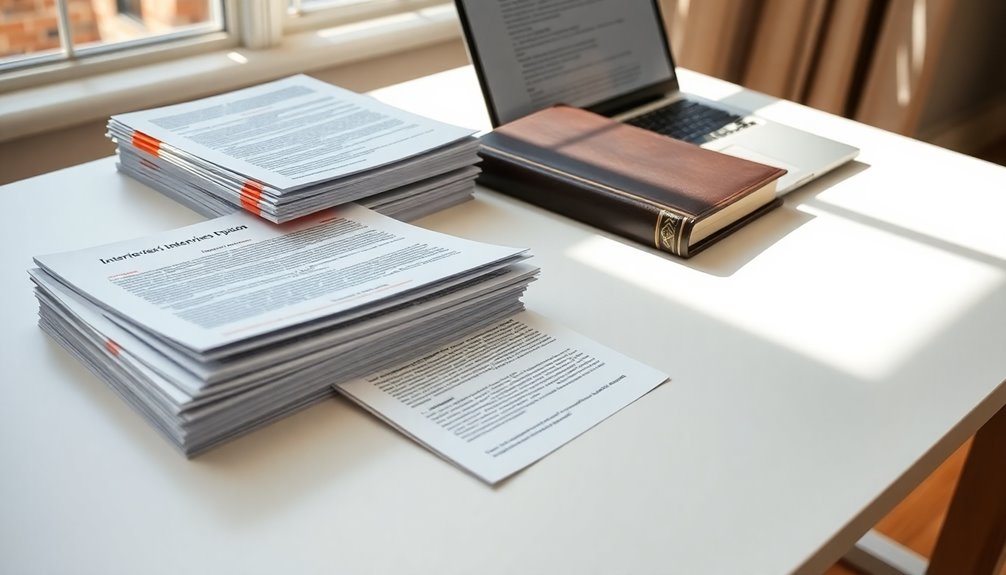Want to see the interviewer's eyes light up? Start by asking open-ended questions that spark meaningful conversations. These questions encourage deeper thinking and show your genuine interest in the role. Next, express your future aspirations clearly, aligning them with the company's goals. Don't forget to showcase your cultural fit by connecting your values with theirs. Finally, share a unique experience that highlights your key competencies. By weaving these elements into your conversation, you'll not only make a lasting impression but also foster a connection. Curious about more tips to enhance your interview skills? There's plenty to explore!
Key Takeaways
- Express genuine enthusiasm for the company's mission, demonstrating alignment with their values and goals to spark the interviewer's interest.
- Share a personal story that highlights your skills and how they contributed to a team's success, fostering an emotional connection.
- Articulate your future aspirations clearly, emphasizing your desire for growth that aligns with the company's trajectory, showcasing long-term commitment.
- Ask insightful, open-ended questions about the company culture and team dynamics, illustrating your genuine interest in collaboration and engagement.
- Highlight a unique skill or experience that sets you apart, creating a memorable moment that captivates the interviewer's attention.
The Power of Open-Ended Questions

Open-ended questions hold a unique power in conversations, transforming simple exchanges into insightful dialogues. When you ask these types of questions, you encourage deeper thinking, leading to a richer understanding of the topic at hand.
Unlike closed-ended questions, open-ended queries allow respondents to express their thoughts and ideas freely, fostering creativity and diverse responses.
Using open-ended questions in interviews helps you unearth unexpected insights that can greatly enhance your discussions. They promote meaningful interactions, allowing you to build rapport with your interviewee. This connection encourages the sharing of detailed opinions and experiences, enriching the data you gather. Additionally, incorporating a balance between open and closed questions can enhance the depth and breadth of the information collected.
You'll find open-ended questions particularly useful during testimonial interviews, discovery calls, and user persona research. They help you get to the heart of what customers are thinking and feeling.
To craft effective open-ended questions, start with phrases like "What do you think about…" or "Why do you feel…?" This approach invites explanations and examples, opening the door to deeper engagement.
Making a Lasting First Impression

To make a lasting first impression, you need to dress for success and convey confidence through your body language. Your attire should reflect professionalism and align with the company culture, while your posture and gestures should radiate self-assurance. Additionally, demonstrating punctuality by arriving early shows your enthusiasm and respect for the interview process.
Dress for Success
While preparing for an interview, dressing appropriately can greatly impact the first impression you make. Your attire speaks volumes about your professionalism and respect for the opportunity.
Here are some key elements to take into account:
- Suit Up: Wear a two-piece conservative business suit in grey or dark blue shades.
- Shirt Selection: Choose long-sleeved shirts or blouses in white or other conservative colors.
- Shoe Game: Select dark shoes and dark socks; black is recommended for men.
- Length Matters: For women, opt for a skirt length a little below the knee, never shorter than above the knee.
- Keep It Simple: Avoid leather, suede, or flashy apparel. A classic business suit is a timeless choice. Maintaining a professional appearance can reflect your attention to detail in other aspects of your work.
Don't forget about grooming! Make sure your hair is neat and well-groomed, and maintain clean nails.
Use minimal accessories and avoid anything that might distract from your professional appearance.
Finally, keep scents discreet and empty your pockets of any items that could cause noise.
Dressing for success isn't just about clothing; it's about presenting yourself as the ideal candidate for the role.
Confident Body Language
Your attire isn't the only thing that shapes the first impression in an interview; confident body language plays a pivotal role as well. Posture, eye contact, and hand movements can greatly influence how you're perceived. Here's a quick guide to help you project confidence:
| Aspect | Tips | Importance |
|---|---|---|
| Posture | Sit up straight, shoulders back | Conveys openness and confidence |
| Eye Contact | Maintain for 2-4 seconds | Shows engagement and attentiveness |
| Hand Movements | Control gestures; avoid fidgeting | Projects calmness and professionalism |
Make sure to offer a firm handshake and breathe deeply to manage nerves. When responding, nod occasionally to show you're engaged. Remember to smile genuinely to portray warmth, but steer clear of negative expressions. Effective body language can enhance your overall presentation, making you appear more approachable and confident. Additionally, demonstrating confidence in your knowledge about relevant topics, such as home security options, can also significantly impress your interviewer. By practicing these body language techniques in everyday conversations, they'll become second nature during your interview. Authenticity is key; inauthentic gestures can be easily spotted. With this confident body language, you'll make a lasting impression that could set you apart from other candidates.
Showcasing Your Future Aspirations

Showcasing future aspirations during an interview is essential for demonstrating how well you align with the company's vision. When you articulate your goals, you not only reveal your ambition but also how you can contribute to the organization's success.
Start by researching the company's mission and culture, then frame your aspirations accordingly. Here are some key points to emphasize:
- Your desire for continuous learning and mastering new technologies to stay ahead.
- Specific company programs or initiatives that resonate with your career goals.
- Your ambition to take on leadership roles and inspire others within the team.
- Past experiences that showcase your passion and align with future aspirations.
- A realistic 5 or 10-year plan that ties your goals to the role you're applying for. Additionally, reflecting on your self-reflection and clarity can help ensure your aspirations are aligned with both your values and the company's objectives. Understanding the importance of trust creation can also showcase your commitment to long-term relationships and stability within the organization.
Understanding Management Styles

Understanding different management styles can greatly impact your interaction and success within a workplace. Each style shapes the dynamics of team performance and employee motivation.
For instance, if you thrive in a creative environment, you might appreciate a laissez-faire style, where independence and innovation are encouraged. On the other hand, if you prefer a structured approach, an autocratic style might resonate more with you, as it provides clear guidelines and expectations.
If you're looking to grow professionally, a coaching management style can be beneficial. It focuses on long-term development and views mistakes as learning opportunities, motivating you to seize career advancements. This approach is particularly effective because it emphasizes employee growth and learning as a foundational element of success.
Meanwhile, transformational leaders push teams to innovate and reach their full potential, fostering a culture of continuous growth.
In collaborative settings, a democratic style invites your input, making you feel valued and involved in decision-making.
Recognizing these styles not only helps you navigate workplace relationships but also allows you to adapt your approach for better outcomes. By understanding how each style influences motivation and performance, you can effectively align yourself with your manager's approach, enhancing your overall experience in the workplace.
Highlighting Key Competencies

Highlighting key competencies can set you apart in a competitive job market. When you're in an interview, mentioning specific skills not only demonstrates your qualifications, but it also shows your understanding of what the role requires.
Here are some competencies that can make a strong impression:
- Managing a Quality Service: Share how you've identified and delivered on customer standards or proactively solved customer issues.
- Effective Communication: Provide an example of how your written communication influenced a decision or how you adapted your style for different audiences.
- Making Effective Decisions: Discuss a time you made a sound judgment under pressure or faced a difficult decision with limited data.
- Leading and Communicating: Highlight a situation where you improved team performance, encouraging all members to participate.
- Customer Understanding: Illustrate how you've effectively understood and addressed customer needs, and how you've responded to feedback. Bulleted lists can enhance your presentation of these competencies, making them easily scannable for the interviewer.
Engaging in Meaningful Conversations

Communicating effectively during an interview goes beyond just showcasing your skills; it's about engaging in meaningful conversations that resonate with your interviewer.
Start by understanding the interviewer's personality and communication style. Are they shy or extroverted? Do they prefer direct questions or a more nuanced approach? Recognizing these aspects can guide your conversation.
Create a safe and engaging environment. Ask if they're open to discussing certain topics, and respect their response if they're not. Eliminate distractions to guarantee you're fully present. Establishing an environment that encourages openness and trust can significantly enhance the quality of your interactions. Additionally, fostering healthy boundaries can help both parties feel respected and valued during the conversation.
Pay attention to their tone and body language while regulating your own emotions. Use clear, direct questions to foster clarity and avoid confusion.
Active listening is essential. Focus on understanding rather than just waiting to respond. Paraphrase their points to confirm your understanding and ask open-ended questions to encourage deeper dialogue.
Show empathy by stepping into their shoes, accepting their perspective without judgment.
Finally, summarize key points to confirm alignment and clarify any next steps. Maintain a positive tone throughout the conversation, demonstrating genuine interest and engagement.
This approach won't only help you connect but also leave a lasting impression on your interviewer.
Demonstrating Cultural Fit

When you approach an interview, it's essential to show how your values and goals align with the company's culture. Emphasizing your experiences in team collaboration can further demonstrate your fit within their work environment. By integrating advanced technology, such as Intelligent Tutoring Systems, into your approach to teamwork, you can illustrate your commitment to shared success and teamwork. Be ready to share specific examples that highlight your commitment to shared success and teamwork. By reflecting on your experiences, you can reveal your understanding of cultural fit and how it influences positive team dynamics.
Aligning Values and Goals
A strong cultural fit can greatly enhance your chances of landing a job, making it essential to align your values and goals with those of the company. Start by researching the company's mission statement and values. Look for resonance between their cultural ethos and your personal beliefs.
To effectively demonstrate this alignment, consider the following:
- Review the company's website and social media for insights into their values.
- Connect with current employees to gauge the workplace atmosphere.
- Prepare real-life examples that showcase your past actions aligning with their values.
- Create a Vision Integration Map to pinpoint where your career goals intersect with the company's vision.
- Anticipate questions about your communication style and preferred working environment, and prepare specific answers.
During the interview, emphasize how your goals and values mesh with the company's vision. Use clear examples to illustrate this connection, showing you're not just a fit for the role but for the company culture as well. Additionally, align your career aspirations with the company's goals to further demonstrate a proactive approach in your potential role. Incorporating educational philosophies into your understanding of the workplace can also show your commitment to fostering a positive environment.
This thoughtful approach will certainly make the interviewer's eyes light up as they see a promising alignment between you and their organization.
Emphasizing Team Collaboration
Aligning your values and goals is just the first step; now it's time to highlight your ability to collaborate effectively within a team. Showcasing your teamwork skills can greatly enhance your cultural fit in the eyes of interviewers. Collaborative workplaces not only boost productivity but also foster innovation and employee satisfaction. In fact, 73% of collaborating employees report improved work quality, which is a testament to the value of effective teamwork. Additionally, understanding how to manage irregular income can further emphasize your adaptability in a team-oriented environment.
| Benefits of Team Collaboration | Impact on Workplace |
|---|---|
| Enhances productivity | Increases performance metrics |
| Reduces burnout and stress | Improves job satisfaction |
| Sparks creativity | Leads to innovative practices |
| Builds stronger relationships | Fosters a sense of shared achievement |
| Improves communication | Resolves conflicts constructively |
When discussing your experiences, focus on how you've contributed to team success, managed conflicts, and communicated effectively. Share specific examples that reflect your collaborative nature, like how you've built on others' ideas or distributed tasks based on strengths. Remember, demonstrating your teamwork skills not only highlights your fit for the role but also illustrates your commitment to creating a positive, innovative workplace culture. Emphasizing these attributes will surely make the interviewer's eyes light up!
Frequently Asked Questions
What Should I Wear to the Interview?
For your interview, choose an outfit that fits the company's culture.
If it's casual, opt for dark jeans with a patterned blouse.
For business casual, consider tailored pants and a button-down shirt.
If it's formal, wear a tailored suit or dress.
Always dress one step above the company norm, and make sure your outfit's clean and pressed.
Comfortable shoes are key, so pick something professional that makes you feel confident.
How Long Will the Interview Last?
Imagine stepping into an interview that feels like a rollercoaster ride—thrilling yet intimidating.
You can expect an in-person interview to last between 45 and 90 minutes on average, while phone interviews usually wrap up in about 15 minutes.
For many roles, 45 to 60 minutes is ideal.
Keep in mind, factors like the job level and interview format can influence how long you'll be in the hot seat.
Can I Bring My Notes to the Interview?
Yes, you can bring your notes to the interview! They can help you stay organized and guarantee you cover key points.
Just remember to use them wisely—avoid reading directly from them and aim for a natural conversation. Having questions prepared shows your genuine interest in the role.
Make certain your notes enhance the interaction rather than distract from it. With the right approach, your notes can boost your confidence and engagement.
What Is the Next Step After the Interview?
What's next after your interview? You've just showcased your skills, so don't let that momentum fade!
First, reflect on your performance—note what went well and areas to improve.
Then, send a thank-you email within 24 hours, expressing gratitude and reiterating your interest.
Gather the interviewer's contact details for follow-ups.
Finally, stay proactive by inquiring about the next steps and preparing for potential second interviews.
Your journey isn't over yet!
How Should I Follow up After the Interview?
After your interview, you should follow up with a thank-you email within 24 hours.
In your message, express gratitude for the interviewer's time, reiterate your interest in the position, and reference specific topics discussed.
Personalizing the email shows engagement and reinforces your fit for the role.
Don't forget to ask for updates on the hiring process.
Keeping it professional and concise will leave a positive impression.
Conclusion
Incorporating open-ended questions and showcasing your aspirations can transform your interview experience. When you engage in meaningful conversations, you not only make a lasting impression but also reveal your cultural fit. By understanding management styles and highlighting key competencies, you create a rhythm that resonates with your interviewer. So, don't hesitate—use these strategies and watch their eyes light up. Remember, it's all about connection, and that connection can open doors to your future.









